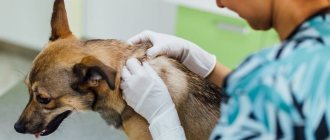Why and how allergies develop in dogs
After the allergen enters the animal’s body, the immune system responds by producing proteins—antibodies—that are capable of forming specific immune complexes.
Prolonged or repeated penetration of the allergen leads to the activation of complexes, which causes the release of inflammatory mediators into the blood - an inflammatory response develops. In addition to external manifestations, negative changes also occur inside the body: the permeability of blood vessels increases, their walls are damaged, the structure of the animal’s own tissues changes (which subsequently causes autoimmune diseases), and so on. It is unknown why the dog’s body is more susceptible to the allergen. However, it is believed that the underlying cause is a dysfunction of the immune system. This may be caused by the following factors:
- heredity;
- prolonged stressful situations;
- the presence of chronic pathologies;
- individual characteristics of the nervous system, hormonal levels;
- helminthic infestations.
Atopic dermatitis
Atopic dermatitis is an inadequate response of the immune system (immediate allergic reaction), formed as a result of an inherited genetic tendency and caused by certain environmental factors (house dust, mold, human skin flakes, other animals, plant pollen).
Causes and predisposed breeds
- Atopic dermatitis most often occurs in dogs between 6 months and 3 years of age.
- It can be seasonal (depending on the allergens that cause it).
- There is no gender predisposition.
- Most often found in dog breeds such as Labrador, West Highland White Terrier, German Shepherd, Jack Russell Terrier, boxer and others. As you can see, among these breeds there are those that are prone to food allergies, so they can go in combination, which can affect diagnosis and treatment.
Atopic dermatitis
Symptoms
Clinically, atopic dermatitis is similar to food allergies.
- First of all, signs appear on the skin, but an allergic reaction can also appear on the mucous membranes ( conjunctiva , nasal mucosa ) and in the respiratory system ( atopic asthma ).
- This is the same itching in the same places ( muzzle , interdigital spaces , elbow bends , armpits , groin , perianal area ), external otitis and recurrent infections (bacterial folliculitis and/or Malassezia dermatitis).
- In this case, there may be a change in the color of the fur on the limbs , and on the front legs - bilateral pododermatitis.
- Erythema on the face (near the eyes and on the lips), inflammation of the lips , and chronic nonspecific inflammation of the skin may be observed .
- Bilateral inflammation of the conjunctiva.
- Seborrhea and hyperhidrosis are not excluded.
As environmental conditions change, the severity of the allergy may also change.
Atopic dermatitis
Diagnostics
Atopic dermatitis is a clinical diagnosis and is not confirmed by tests. It is confirmed by a combination of characteristic symptoms, excluding other causes of itching. Allergy tests are not a 100% diagnostic option, but if everything points to atopic dermatitis, including allergy tests, this can increase confidence in the diagnosis. If allergy tests do not reveal anything, treatment will still be the same as for atopic dermatitis confirmed by allergy tests.
Atopic dermatitis
Treatment of atopic dermatitis
Treatment of atopic dermatitis is always lifelong . In this case, it is necessary to control the factors leading to exacerbations (secondary infections, food reactions, ectoparasites) and control itching. You can control itching by:
- Antihistamines
- Corticosteroids
- Cyclosporins
- Specific immunotherapy
Antihistamines
Unfortunately, antihistamines are not able to act on the receptor already associated with histamine, so they will have little effect on allergies that already exist. However, they can prevent its development. They are very poorly absorbed in animals, so their doses will be significantly higher than those in humans, and they are effective in less than 30% of animals, so you should not rely on them. At the same time, they are completely harmless. When used with fatty acids and hormones, they can exhibit synergism - mutual enhancement of action, that is, the dose can be reduced.
Corticosteroids
Glucocorticoids effectively influence itching, while they have a nonspecific anti-inflammatory effect and inhibit (suppress) the synthesis of inflammatory proteins.
Prednisolone and methylprednisolone are the first choice drugs Their average duration of action is half-life, 12-36 hours. The stronger the hormone, the more pronounced the side effects (dexamethasone). Side effects often occur in dogs , so long-acting hormonal medications are not recommended. The longer a hormonal drug is used in treatment, the slower it will subsequently need to be discontinued, since stopping the supply of the hormone in the same amount can cause withdrawal syndrome. It is advisable to combine treatment with hormones (the same fatty acids, antihistamines, local treatments) in order to shorten the duration of the course of treatment. Therapy with hormonal drugs always begins with maximum doses, followed by their reduction to the minimum effective, and not vice versa.
Atopic dermatitis
Side effects
Side effects may include behavioral changes , vomiting , diarrhea , and most commonly polyuria (increased amount of urine produced) and polydipsia (increased thirst).
With long-term treatment, various side effects may develop:
- Secondary infections
- Osteoporosis
- Muscle atrophy
- Steroid hepatitis, pancreatitis
- Adrenal suppression
- Weight gain
- Saggy belly
- Diabetes
- Cataract
This once again confirms that the course of treatment should be shortened as much as possible.
From the skin:
- Atrophy
- Secondary infections
- Alopecia
- Poor wound healing
- Hemorrhages
An animal that is undergoing hormone treatment should be regularly observed by a veterinarian and be under the watchful supervision of the owner.
Common Signs of an Allergic Reaction in Dogs
How do allergies manifest in dogs? It depends on the type of allergen. The body can respond with inflammatory processes in the mucous membranes, respiratory tract, muscle tissue, skin, digestive organs, and so on. However, there are some general signs that you should definitely pay attention to:
- dry, flaky skin;
- the appearance of bald spots, bald patches;
- discharge from the nostrils;
- swelling of the conjunctiva;
- frequent itching;
- increased lacrimation;
- redness of the inner surface of the ears;
- increased humidity in the armpits;
- digestive problems, gastrointestinal disorders;
- wheezing, shortness of breath;
- changes in the psyche (irritability, aggressiveness).
Attention: if the reaction to the allergen is very violent, the dog may develop Quincke's edema. If your animal's face is swollen, breathing is impaired, or its eyes are swollen, you should immediately seek help from a veterinarian.
Since allergy symptoms are similar to many diseases, an accurate diagnosis can only be made after a thorough examination of the dog.
Frequent itching
The appearance of bald spots
Discharge from the nostrils
Redness of the inner surface of the ears
Redness on the paw
Redness on the chest
What causes a rash
Where does a dog get a rash on its stomach? The appearance of irritation can be due to various reasons, so it is not immediately possible to make an accurate diagnosis. The appearance of dots on the skin of an animal is often associated with flea bites. One common cause of itchy spots is food allergies. If there is an excess of protein in a dog's diet, this may lead to such a reaction.
Veterinarians identify the following causes of a rash on the stomach of a dog:
The appearance of red spots can also be caused by allergies to shampoo. If a rash occurs after swimming, you need to change your detergent.
Diagnostics
When diagnosing allergies in dogs, a specialist will prescribe a comprehensive examination. It is possible to exclude other diseases using blood tests, urine tests, stool tests for worms, skin scrapings and many other methods. The difficulty in identifying an allergen lies in the fact that the symptoms of the conditions are very similar. In this regard, the exclusion method is used, that is, possible allergens are examined one after another. The first thing people pay attention to is food and parasitic insects.
If signs of allergy appear, it is necessary to diagnose the causes for subsequent treatment.
To identify food allergies, the animal is given a special diagnostic diet. The pet will have to eat a certain type of food for about two months, including/excluding various protein foods. The owner is obliged to record the presence or absence of changes in the protein map. If a food allergen is detected, it is permanently excluded from the diet. This method is the only one that makes it possible to identify a product that is allergenic to a dog.
To establish a flea allergy, a test with a white piece of paper soaked in water is used. Insects leave “waste” of their digestion on the animal’s body in the form of black spots. On a wet leaf, these inclusions blur into red spots.
If necessary, diagnostic tests can be performed.
- Intradermal test. The dog is injected subcutaneously with a small amount of the allergen, and then the immune response is analyzed.
- Blood test for antibodies. It is performed by adding a small volume of blood to the suspected allergen.
Laboratory diagnostics are rarely used. This is due to the high cost of such tests, the long wait for results, as well as their lack of reliability.
Possible diseases
If a rash appears on your dog’s stomach and itches, it is possible that this is a signal of serious health problems. In order not to start the disease, you need to pay attention to such changes and seek veterinary help as quickly as possible.
Swollen red spots on a dog's skin can cause the following diseases:
Types of allergies in dogs
Just like people, dogs suffer from various types of allergic reactions.
- Atopic. Caused by genetic characteristics. It can develop to any irritant (dust, poplar fluff, mold), so it can be almost impossible to detect the allergen.
- Respiratory. Occurs when a dog inhales an immune response pathogen. Characteristic symptoms are respiratory disorders.
- Autoimmune. This is an allergy to your own cells.
- Contact. Caused by direct contact of the dog’s body with allergenic objects.
In each case, the key to successful therapy will be the complete exclusion of the allergen.
Allergy to food
Food allergies develop in dogs mainly as a response to protein, so any product containing this component can cause it. The most common allergens are meat products, chicken egg whites, grains and legumes (wheat, soy). Artificial additives contained both in animal feed and in ordinary products can lead to allergies: flavors, dyes, preservatives.
There is an opinion that the most common allergy among four-legged friends is chicken. In fact, this type of allergic reaction is not much more common than others. Even pig meat or soy products cause a much stronger response from the immune system.
Symptoms of a food allergy may include the following:
- skin itching, rashes;
- local hair loss;
- mucus discharge from the eyes;
- indigestion;
- itching and/or discharge in the ears, swelling of the ears and others.
Treatment of food allergies consists of identifying the allergen, eliminating it, and medicinal relief from symptoms.
Food allergies are one of the most common
Flea allergy
Allergy to flea bites is also based on the body's reaction to foreign proteins. During damage to the skin, an insect injects a special secretion containing enzymes and various active substances into the tissues of the animal. Some dogs can withstand even numerous bites, and especially sensitive ones can react to fleas even if there is only one insect.
Symptoms of a flea allergy may include the following:
- hyperemia of the epidermis;
- scratching due to constant itching;
- rashes in the groin area;
- scabs.
When examining the dog externally, the owner may not see fleas. For an allergic reaction to develop, it is enough for an insect to bite, after which the flea can leave the animal’s body.
Therapy in this case consists of destroying blood-sucking insects (if there are none, then preventive treatment is carried out) and eliminating symptoms with medications.
Allergy to medications
Cases of an allergic response of a dog’s body to medications are not uncommon. The most common allergens are:
- antibacterial agents;
- vaccines;
- vitamin preparations.
Drug allergies may not appear immediately. This type of immune response, in most cases, manifests itself as the substance accumulates in the dog’s body.
Attention: despite the gradual development of an allergic reaction (which is the most common), some pets may experience a sharp response in the form of swelling of the respiratory tract, suffocation, and anaphylactic shock. Therefore, when taking medication for the first time, you need to carefully monitor the animal’s condition.
Symptoms of drug allergies include: rash, intestinal disorders, and heart problems. Treatment consists of immediate cessation of medications and symptomatic therapy. In severe cases, you should immediately contact a veterinary clinic.
Allergies to medications in dogs
Allergy to hygiene products and household chemicals
Dogs react sensitively to components of household chemicals and hygiene products. This form of allergy can appear after direct treatment of the animal (for example, washing with inappropriate shampoo), as well as as a result of washing bedding, using detergent additives when washing the floor, and so on.
Manifestations of this type of immune response may include:
- hair problems;
- dermatitis and dermatoses;
- lacrimation;
- discharge from the nostrils;
- swelling of the conjunctiva, redness of the organs of vision;
- sneezing and others.
It is difficult to detect the allergen in this case. Since allergies to food and fleas are primarily suspected, it will take about two months to eliminate these allergens. During this period, the symptoms of an allergic reaction to hygiene and detergents may worsen. If a foreign agent is detected, it is completely excluded from the dog’s life and appropriate symptomatic therapy is carried out.
Boss, are you sure I won’t have allergies after all these shampoos?
Other types of allergens
Dogs have a wide variety of allergies. So, the pet’s body may react inadequately to:
- feather;
- helminths;
- fungal infection, bacteria;
- plant pollen or indoor plants;
- other domestic animals (birds, cats);
- natural or, on the contrary, synthetic fabrics.
It will take more than one month to identify such an allergen. In many cases, the animal suffers all its life, since it is not possible to determine the causative agent of the pathology.
First aid
The symptoms of anaphylactic shock are always the same, regardless of its cause. It occurs local and systemic. The first form sometimes turns into the second. Usually appears due to bites and drug injections.
Signs of local anaphylaxis:
- urticaria (itching, rashes, redness of certain areas);
- angioedema (under the skin and in the deep layers of tissue).
Symptoms of systemic anaphylaxis:
- vomiting, sudden changes in mood (depression is observed after excessive excitement);
- breathing problems;
- loss of consciousness, cardiovascular failure.
If there is a risk of occurrence or pathology has directly arisen, you should immediately take your pet to a veterinary clinic.
First aid must be provided within an hour, otherwise there will be death. The doctor uses the following means:
- Diphenhydramine or suprastin at a dose of 0.2 ml/kg intramuscularly.
- Cordiamine intravenously (0.02-0.6 ml/kg) or sulfocamphocaine subcutaneously (0.2 ml/kg) - they support the proper functioning of the heart.
- Dexon, dexamethasone or hydrocortisone (0.5-1 mg/kg) subcutaneously. The dosage is affected by the weight of the pet.
- A mixture of ascorbic acid and glucose intravenously.
- Immunofan (1 ampoule) intramuscularly.
After introducing the above measures within 24 hours:
- Take 1-5 tbsp calcium chloride per day. l.
- Replace regular liquid with a decoction of string for constant drinking.
- Relieve itching using hydrocortisone spray 2-3 times a day. To create this product you will need hydrocortisone (4 pieces), alcohol (80 ml), glycerin (50 ml), water (350 ml). Mix the ingredients and pour into the sprayer.
In the case when a wasp has bitten and angioedema has formed (sudden swelling of the eyes or muzzle) and the situation is not too advanced, the pet is given Tavegil, Claritin or Suprastin. If the muzzle is very swollen, you will need an injection of Suprastin, Adrenaline or Tavegil.
The dangers of allergies in dogs
If the allergen is not identified and eliminated, the dog will suffer from symptoms constantly, resulting in serious disruptions in the functioning of all organ systems. Lack of treatment can lead to diseases such as:
- chronic dermatosis;
- hormonal disbalance;
- psychical deviations;
- pulmonary edema, respiratory arrest;
- chronic conjunctivitis;
- heart pathologies;
- baldness;
- anaphylactic shock.
Since the body is weakened, a secondary infection occurs in the form of bacteria, fungi, and viruses. In severe cases, the pathology leads to the death of the pet.
How to treat allergies in dogs
How to relieve allergies in dogs, how and with what to treat its symptoms? This depends on various factors: the severity of the disease, the presence or absence of a secondary infection, the condition of the pet (newborn puppy, pregnancy, old age) and others. Therapy should be comprehensive and include activities such as:
- identification and elimination of the allergen;
- hypoallergenic diet;
- drug relief from symptoms.
It is necessary to introduce restrictions in the diet not only to identify food allergies, but also for other types of immune response.
If your pet has a malfunction of the lacrimal glands, swelling of the conjunctiva, purulent discharge from the eyes, appropriate drops, ointments and rinses are prescribed. In case of skin lesions and hair loss, external antiseptic, antipruritic, healing agents are indicated, and in the case of a secondary infection, antibacterial ointments and preparations for internal use. Other symptoms are treated in a similar way. If your pet suddenly develops swelling of the mucous membrane of the mouth and eyes, and the dog begins to choke, then you need to urgently call a veterinarian or take the animal to the nearest clinic.
Heal me completely
Treatment and care
All types of allergies in dogs and their treatment involve eliminating allergens and existing symptoms. Patients are prescribed medications and prescribed a hypoallergenic diet.
First aid for anaphylactic shock
If allergic symptoms are detected, veterinarians recommend refraining from self-treatment. An exception is allowed only in the case of anaphylactic shock (anaphylaxis), a deadly, rapid reaction. It is caused either by drug injections and insect bites, or by ingestion and sudden inhalation of large quantities of the irritant. Depending on the cause, the condition is accompanied by:
- acute pain at the injection/bite site or in the abdomen;
- redness and swelling of the affected area;
- vomiting and diarrhea;
- itching, covering not only the contact site, but also other areas;
- swelling in the throat;
- lowering blood pressure.
No more than an hour is allotted to save a pet. The victim is administered intravenously or intratracheally (through the trachea) adrenaline and epinephrine. Not all owners are able to do this on their own, so it is safer to contact a veterinary or dental clinic. Anesthetics used in dental treatment often cause allergic reactions, so dentists always have all the necessary medications in case of anaphylaxis.
Prescribed medications
In addition to eliminating the irritant and relieving symptoms, treatment involves caring for the affected skin and taking immunomodulators. The choice of drugs directly depends on the form of the disease:
- Food
. Proteins are excluded from the diet until symptoms disappear completely. Over time, prohibited products are returned, and the allergens found are eliminated.
- Seasonal
. Antihistamines are used regularly during the flowering period.
- Contact
. To eliminate itching, swelling and other signs of the disease, antihistamines are prescribed.
- Insect
. First of all, the animal is rid of parasites. After their destruction, the condition returns to normal.
- Atopic and autoimmune
. Instead of antihistamines, glucocorticosteroids are used and suppress the immune system.
- Infectious
. Once the underlying cause of the disease is identified, the virus or other infectious agent is destroyed with antibiotics.
Most options involve taking antihistamines. The most popular include Suprastin, Ketotifen, Claritin, Diphenhydramine and Promethazine.
Nutrition and special feed
For 2 months, the animal is put on a therapeutic diet that excludes major allergens. When dry feeding, hypoallergenic super-premium or holistic-class food is used. In the second case, the diet is not changed, but in the first, it is gradually changed to the original, simultaneously eliminating the identified allergens.
What to feed your dog during allergy treatment
In case of an allergic reaction of any kind, the animal needs a special diet. It is necessary to exclude from it all foods that the body tolerates the most:
- chicken, pork and beef meat;
- wheat products;
- yeast based products;
- fish;
- egg white;
- products with soy additives.
Hypoallergenic food
You should feed your pet predominantly natural food that does not contain coloring, preservatives or flavorings. Such additives further disrupt the functioning of the immune system and metabolic processes. Products that do not cause allergies: turkey, rabbit and lamb meat, buckwheat, brown rice.
Dog owners who are accustomed to commercial food need to carefully review the composition of the food. Today, there are special hypoallergenic types of food on sale that do not contain artificial ingredients, enriched with omega-3 fatty acids, antioxidant compounds and other beneficial components. Among them are:
- Hills Prescription Diet Canine Allergen-Free;
- Acana Lamb&Okanagan Apple;
- Bosch Sensitive Lamb & Rice.
Features of occurrence and causes
A similar immune reaction to various substances can develop in pets of all breeds: the exterior does not affect the body’s susceptibility. However, there is no need to panic ahead of time: a balanced diet and proper care will help you keep your four-legged friend as safe as possible. First, you need to understand the origins of the disease and how it manifests itself.
Why does my pet constantly itch and the affected areas of the skin become wet and red? This is due to irritants that become real enemies of the animal’s immune system. The eating type of this disorder is associated with a negative reaction to a protein source. This disease is one of the most common in pets. It can be caused by various substances. The list includes:
- Products that we give to the dog every day. For those who have repeatedly encountered a similar problem, it is no secret that a mixed diet leads to numerous rashes. Allergies lead to:
- source of protein - poultry meat, both boiled and raw;
- eggs;
- milk, sour cream, kefir, etc.;
- river and sea fish (including canned fish);
- soy products;
- products containing yeast;
- all vegetables and fruits of bright colors: red apples and peppers, citrus fruits;
- Fish oil that is beneficial for puppies can lead to illness;
- oils;
- sweets that should never be offered to your pet: chocolate, sugar;
- herbs, spices;
- everything salted and fried;
- The dog may be allergic to buckwheat;
- smoked meats (hams, sausages, etc.)
- Medicines:
- various antibiotics;
- antimicrobial drugs containing white streptocide;
- serums and suspensions containing live bacteria;
- morphine;
- chloral hydrate – a sedative and analgesic;
- B vitamins, etc.
- Cosmetics (usually cheap and low-quality shampoos) and household chemicals;
- Excessive dander or hair from a shedding animal can cause irritation;
- Parasites (fleas, ticks);
- Worms, fungi and dangerous viruses - in this case the disease will be infectious in nature.
Allergies to cold, chicken, protein... The list goes on and on. All owners have at least once encountered an insidious reaction: it can appear an hour after contact with a product or parasite, or a month later.
This is interesting
The effect of the irritant on the body, in the latter case, occurs in a cumulative manner: first, the immune system takes this or that substance, then defeats it, and then becomes more and more vulnerable under the onslaught of new and new attacks. The result, as a rule, is deplorable: the surrendered organism begins to give one signal for help after another.
Help with anaphylactic shock in a dog
The state of anaphylactic shock can occur suddenly as a result of a sharp response of the animal’s body to an insect bite, taking or injecting medications, or vaccination. It is characterized by the following symptoms:
- swelling of the muzzle, eyes, mouth, nose, ears;
- rash and redness, swelling at the injection site;
- vomiting reflex;
- an excited state turning into a depressed state;
- heart rhythm disturbance;
- fainting state.
If such signs occur, the animal must be urgently taken to a veterinarian. The pet may die within the next hour!
First of all, the specialist will give an intramuscular injection of an antihistamine, for example, diphenhydramine. To maintain heart function, an intravenous infusion of cordiamine or an injection of sulfocamphocaine under the skin will be required. In addition, the veterinarian will administer a mixture of vitamin C and glucose intravenously, an immunomodulatory agent (for example, Immunofan) intramuscularly, and a steroid drug subcutaneously. Further actions will depend on the condition of the dog.
Allergies are very difficult for dogs. The inability to reliably determine the antigen using laboratory methods further complicates the situation. The owner will need to have a lot of patience, show maximum care and attention in order to detect the allergen and save the pet from suffering.











